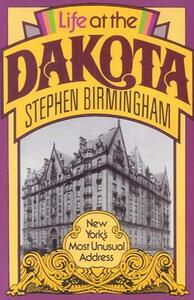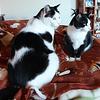Take a photo of a barcode or cover
Some of it was interesting but for the most part it was a snobbish point of view and would only appeal to the actual tenants of the building.
First book I think I have read about a building and quite a good read I must say. Somewhat dated since it was written so long ago, but interesting nonetheless. What an absolutely beautiful building in a fabulous location! I guess I learned a lot about the NY social scene and politics in this book because I guess this was a (and to some still is) terrible location. I love the history of the price here, the workers here, the menus, the elevators, those that live on the top floors etc. The catty fighting of the residents was my least favorite part of the book. I don't care a whole lot about stars, politicians and the like now and what they fought about in this building oh-so-long-ago really is of very little interest to me. But I guess that is all part of the history of the building.
Life At The Dakota: New York´s Most Unusual Address
by Stephen Birmingham
1979 / 1996
Syracuse University Press/ Open Road Media
I enjoyed this lively and enthusiastic history of one of New Yorkś most well known apartment buildings, The Dakota. It was openly snubbed by high society on the ¨East Side¨, especially the Astor Family, for being on the less desirable West Side. However, since its opening in 1884, there were no vacancies until 1929. 90% of the original families came from man-made first generation money, and remained in the Dakota until their death.
From its inception, there have been many unexplainable events. The elevators, the first to be installed in a residential building were said to be haunted. Objects moved by themselves. Soft voices mumbling were heard in the walls. Odd creaks were frequent. Freak accidents, some resulting in death, surround the building and its sidewalks. It was managed by Elise Vesley for years. As one of the leaders of the Vedantist movement promoted by Christopher Isherwood and Swami Prabhavanda, many tenants feared her. She also believed she had the power of psychokinesis. When her only son was struck and killed by a speeding truck in front of the building, Elise never recovered.
Roman Polanski used the Dakota exterior for his film ´Rosemaryś Baby´. There are many strange and interesting stories of the tenants that lived here and although it was published years ago, in 1979 originally, it is still vibrant and fascinating. I never realized how many unexplainable events happened at The Dakota.
Some interesting tenants include Roberta Flack, the first African American to live there; Judy Holliday; Jose Ferrer and Rosemary Clooney; Judy Garland; Lauren Bacall; Leonard Bernstein and John Lennon.
The Dakota went from being a private apartment building in 1884, to a being a part of a foundation in the 1960ś. It is an interesting and intriguing part of the history of New York. And itś past.
Recommended.
by Stephen Birmingham
1979 / 1996
Syracuse University Press/ Open Road Media
I enjoyed this lively and enthusiastic history of one of New Yorkś most well known apartment buildings, The Dakota. It was openly snubbed by high society on the ¨East Side¨, especially the Astor Family, for being on the less desirable West Side. However, since its opening in 1884, there were no vacancies until 1929. 90% of the original families came from man-made first generation money, and remained in the Dakota until their death.
From its inception, there have been many unexplainable events. The elevators, the first to be installed in a residential building were said to be haunted. Objects moved by themselves. Soft voices mumbling were heard in the walls. Odd creaks were frequent. Freak accidents, some resulting in death, surround the building and its sidewalks. It was managed by Elise Vesley for years. As one of the leaders of the Vedantist movement promoted by Christopher Isherwood and Swami Prabhavanda, many tenants feared her. She also believed she had the power of psychokinesis. When her only son was struck and killed by a speeding truck in front of the building, Elise never recovered.
Roman Polanski used the Dakota exterior for his film ´Rosemaryś Baby´. There are many strange and interesting stories of the tenants that lived here and although it was published years ago, in 1979 originally, it is still vibrant and fascinating. I never realized how many unexplainable events happened at The Dakota.
Some interesting tenants include Roberta Flack, the first African American to live there; Judy Holliday; Jose Ferrer and Rosemary Clooney; Judy Garland; Lauren Bacall; Leonard Bernstein and John Lennon.
The Dakota went from being a private apartment building in 1884, to a being a part of a foundation in the 1960ś. It is an interesting and intriguing part of the history of New York. And itś past.
Recommended.
I can't help it, I love to read about real estate and zany rich people. This one from 1979 is wonderfully entertaining. I was even captivated by the minutiae of the Dakotans going co-op. The ending was a tiny bit depressing, what with the way the building was deteriorating. I gasped in horror at the mention of people tearing down their walnut paneling and painting over their fireplaces, although it is difficult to lament the changing of the times when it comes to social attitudes. I'm sure the Dakota is as elitist today as ever, but hopefully not as discriminatory.
A social history that places The Dakota at the center of life in New York City. The book follows the gamble of building the Dakota on the West Side, the unique architecture of the building, the original tenants, and the eventual transition from rental apartments to condo ownership.
informative
slow-paced
This book was suggested to me by similar Amazon purchases, so I picked it up with my Audible credit. I love books about historical buildings of all kinds. I actually became aware of the Dakota through a podcast episode about Mark David Chapman murdering John Lennon outside of it. I had no idea that this building was built by Edward Clark, Singer sewing machine magnate. The story of construction wasn't terribly interesting to me, but how the building wound up with the name Dakota was neat. I also had no idea that Roberta Flack was the first African American resident of the Dakota. There were a lot of famous names mentioned in this book with stories and anecdotes about them. If you are interested in celebrities, this might be a book for you. I have a couple of other books of similar topic, and I am looking forward to reading them as well.
informative
reflective
slow-paced
This was an entertaining social history of the Dakota apartment building in New York. The early parts of the book discusses the early history of the building, its first tenants, & its place in the history of the city & this is where the book is at its most interesting. Who knew that early apartment buildings & hotels were frowned upon because they were so much like the tenements of the day?
The last bit of the book is a bit gossipy, but that's also delicious in its own way, although somewhat disconcerting after the earlier historical writing. There are some cool photographs, as well, but I would've liked to have seen more photos of the interior of the building - maybe not the insides of people's apartments, but surely there's a picture of the lobby somewhere!
I love the notion of this building going up on the west side of Central Park & being called the Dakota because at the time it was so far out west. Its original budget was a million dollars & it took four years to build - from 1880 to 1884.
This, of course, is where John Lennon lived & where he was shot. The exterior of the building has been used in a couple of movies, Rosemary's Baby most notably, but they don't allow filming inside.
This is an enjoyable, if not terribly scholarly, book.
The last bit of the book is a bit gossipy, but that's also delicious in its own way, although somewhat disconcerting after the earlier historical writing. There are some cool photographs, as well, but I would've liked to have seen more photos of the interior of the building - maybe not the insides of people's apartments, but surely there's a picture of the lobby somewhere!
I love the notion of this building going up on the west side of Central Park & being called the Dakota because at the time it was so far out west. Its original budget was a million dollars & it took four years to build - from 1880 to 1884.
This, of course, is where John Lennon lived & where he was shot. The exterior of the building has been used in a couple of movies, Rosemary's Baby most notably, but they don't allow filming inside.
This is an enjoyable, if not terribly scholarly, book.
This was a daily sale book for a dollar, but it intrigued me. I am so glad I picked it up! This was an entertaining history of New York City life from the late 1800’s through 1979, the time the book was published. The author did quite a bit of research as well as interviews with residents and staff, resulting in a fascinating look at this New York icon and its residents. The builder was Edward Clark, partner of Isaac Singer, of the Singer sewing machine fame. It began as a luxury apartment building, with service beyond any that can be imagined today. It received its name because it was so far west, it may as well have been in the Dakota Territory.
Over the years, the Dakota has been home to many notables, celebrities and elitists. Yet I found the most interesting person of all was someone I had never heard of before, Mihajlo (Michael) Pupin. Dr. Pupin was born in a small rural village in what is now Serbia. At 16, he came to the U.S. with 5 cents and a dream. He worked, went to college and became a physicist and mathematician, a pioneer and inventor, an educator and philanthropist. I found the books excerpts from an interview with him absolutely fascinating and had to research him further. That is an amazing tale on its own.
An interesting side note, reading this not quite 40-year old book showcased the changes in our society in the last 40 years. Yes, we still have elitists and snobs and we always will,, but we have advanced a long way in 40 years. This was a very interesting read.
https://candysplanet.wordpress.com
Over the years, the Dakota has been home to many notables, celebrities and elitists. Yet I found the most interesting person of all was someone I had never heard of before, Mihajlo (Michael) Pupin. Dr. Pupin was born in a small rural village in what is now Serbia. At 16, he came to the U.S. with 5 cents and a dream. He worked, went to college and became a physicist and mathematician, a pioneer and inventor, an educator and philanthropist. I found the books excerpts from an interview with him absolutely fascinating and had to research him further. That is an amazing tale on its own.
An interesting side note, reading this not quite 40-year old book showcased the changes in our society in the last 40 years. Yes, we still have elitists and snobs and we always will,, but we have advanced a long way in 40 years. This was a very interesting read.
https://candysplanet.wordpress.com
More 2 1/2 stars. I got a kick out of reading a 40 year old book recalling the history of The Dakota. The "current" part of this book was the equivalent of the author writing about the Depression era of the apartment building. For me at least, it really highlighted just how long ago the 70's were. The casual homophobia of some of the residents - how the board decided not to sell to homosexuals because they didn't want the building to become "camp" and "Andy Warhol-ish" plus you know how slutty those gays are - OMG it was crazy to come across. Not to mention the portrayal of "colored" Roberta Flack. Yikes! Gosh, isn't the board so magnanimous to sell to her? As one original resident puts it, she thinks "the browns & yellows & reds are the same as the whites" which is a nice thought for someone of her generation but stated in such a dated, racist way. The antisemitism was not quite as over the top but it was there too. Following the development of the apartment building is like following the development of society so there are some doozies in the descriptions. Don't go into this book thinking there will be a twenty first century sensibility.
It was also jarring to keep reading about "the John Lennons" and what kind of tenants they were, knowing that in less than a year after the book's publication he would be murdered on the Dakota's doorstep. The author tells us that John & Yoko weren't considered chic and that Lennon struck everyone as kind of a has-been. Interesting. Wondering how everyone's concept of him changed after the murder? I was hoping for an epilogue by the author, some sort of what it's like twenty years later sort of thing, but no such luck.
The first half of the book is definitely much better than the second half. I enjoyed reading about the design & construction of the building. All the amenities offered were nuts. That private dining room! Those daily menus were mental. All that fancy food. And you could have it delivered to your apartment if you didn't feel like coming to the dining room. The laundresses that came and took your laundry & returned it clean & folded wrapped in tissue paper. Ah, what a life! The chapter about all the ghosts at the Dakota was fun as well. Total bullshit of course, but entertaining to read the stories.
The book took a turn for the worse starting in 1969 when the building went co-op. Yawn. The author gave waaaay too much detail. I don't need the entire resignation speech of a board member published. The author wrote about a lot of the residents as if they were way more famous than they actually are. Maybe they were more well known then? I dunno. I read a lot about that era in NYC so feel like I would have known them if they were. At one point he lists about 25 guests at some resident's party as if it was the most amazing list of people. Eh. Lee Radziwell(Jackie O's sister) was the most famous name in the bunch.
Reading this book made me want to go search out a coffee table book about the building, one showing lots of photos. It turns out that I am more interested in the building itself, rather than the residents. Certainly not a book worth buying, but as a library book, it was worth checking out.
It was also jarring to keep reading about "the John Lennons" and what kind of tenants they were, knowing that in less than a year after the book's publication he would be murdered on the Dakota's doorstep. The author tells us that John & Yoko weren't considered chic and that Lennon struck everyone as kind of a has-been. Interesting. Wondering how everyone's concept of him changed after the murder? I was hoping for an epilogue by the author, some sort of what it's like twenty years later sort of thing, but no such luck.
The first half of the book is definitely much better than the second half. I enjoyed reading about the design & construction of the building. All the amenities offered were nuts. That private dining room! Those daily menus were mental. All that fancy food. And you could have it delivered to your apartment if you didn't feel like coming to the dining room. The laundresses that came and took your laundry & returned it clean & folded wrapped in tissue paper. Ah, what a life! The chapter about all the ghosts at the Dakota was fun as well. Total bullshit of course, but entertaining to read the stories.
The book took a turn for the worse starting in 1969 when the building went co-op. Yawn. The author gave waaaay too much detail. I don't need the entire resignation speech of a board member published. The author wrote about a lot of the residents as if they were way more famous than they actually are. Maybe they were more well known then? I dunno. I read a lot about that era in NYC so feel like I would have known them if they were. At one point he lists about 25 guests at some resident's party as if it was the most amazing list of people. Eh. Lee Radziwell(Jackie O's sister) was the most famous name in the bunch.
Reading this book made me want to go search out a coffee table book about the building, one showing lots of photos. It turns out that I am more interested in the building itself, rather than the residents. Certainly not a book worth buying, but as a library book, it was worth checking out.




